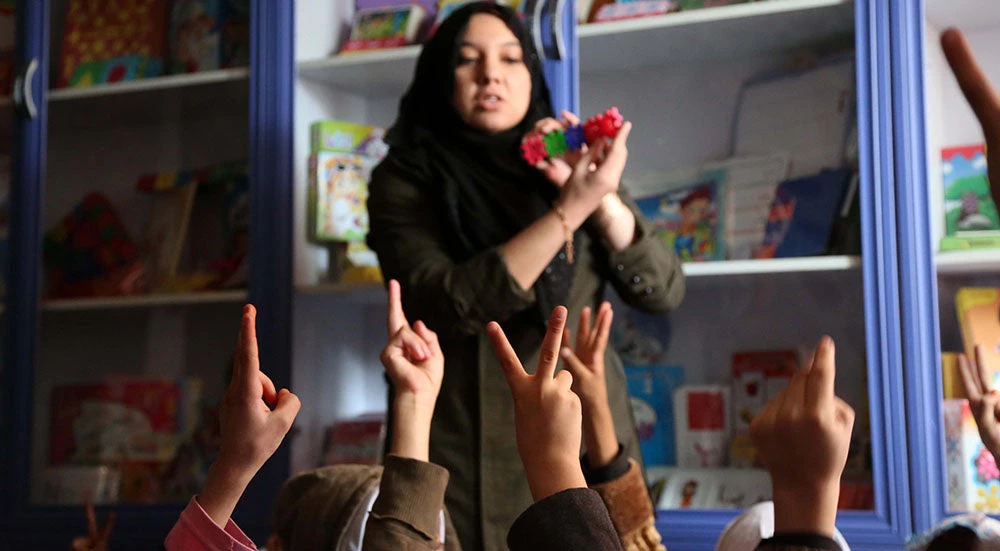 Teacher Alia asking numbers from her students using toys.
Teacher Alia asking numbers from her students using toys.
A few years ago, one of my secondary school teachers passed away. His name was Juan Canal and he taught history and geography. But this is not what I remember the most about him. What I remember are his efforts to engage and capture the imagination of all students, even of those less comfortable discussing Ancient Greece or the pre-Inca cultures. I remember his eagerness to find innovative ways to engage students, and our discussions on leadership and social responsibility. I didn't really grasp the significance of those discussions at the time. However, I remember those debates decades later.
Teachers shape the future of millions of students every day, affecting how we treat each other, the way we work, how productive we are, and even how happy and confident we are as adults. Through this, they shape societies and countries. Everyone remembers by name that teacher that many years ago said or did something that was an inspiration, a life changer. Those are the teachers that understand how critical their day-to-day actions and behaviors are in shaping the futures of their students.
Research shows that the quality of teachers is a major determinant of children's learning and well-being. Going from a poor-performing teacher to a great teacher can increase student learning by multiple years of schooling.Great teachers also have a substantial impact on the well-being of students throughout their lives, affecting not only their academic achievement, but also other long-term social and labor outcomes.
Yet, a large share of children do not have access to high quality teachers. A survey in six countries in Sub-Saharan Africa showed three worrying facts.
- First, high teacher absence leads to students receiving only two hours and fifty minutes of teaching per day, just over half the scheduled time. Teachers being absent is the clearest symptom of a lack of understanding of the importance of the teacher-student interaction for learning.
- Second, 84 percent of grade 4 teachers have not reached the minimum level of mastery of the curriculum they teach.
- Third, less than 1 in 10 teachers exhibit good teaching practices, such as regularly checking for student’s understanding and providing feedback.
Studies in Afghanistan, India, Pakistan, Lao PDR, Peru, and Tanzania show similar quality issues in different settings.
Poor teaching is not the fault of the teachers, but the result of system-level policies that do not appropriately recruit, prepare, support, manage, and motivate teachers. A handful of countries, such as Finland, Japan, and Singapore, boast a cadre of successful teachers. In most other countries, teacher policies are either ineffective or lack internal consistency. Entry into teacher preparation programs might lack selectivity, and teacher entry-level qualifications might be set much lower than other professions. Good teacher performance might not be recognized or rewarded. Teachers hiring or promotion might be stained by politics or clientelism. Unprepared and poorly trained teachers might be expected to teach a complex curriculum, which even they have a weak grasp on.
Too many students across the world sit in classrooms exposed to ineffective teaching every day, every year, as they go through school. No wonder that schooling does not assure learning and that we are living a learning crisis.
Covid-19 has deepened the crisis. The pandemic has challenged education systems to ensure learning continuity, substantially increasing the demands placed on teachers. Education systems, more than ever, require effective teachers that facilitate and support learning instead of delivering content; that use a combination of in-person and digital methods to deliver lessons; that foster creative thinking, communication, and collaboration; and that instill a love of learning, how to persevere, and have self-control.
As schools gradually reopen, teachers will have the challenge of rapidly assessing students’ knowledge to identify learning gaps and adapt their teaching to the level of each student. Further, they will need to provide psychosocial support and manage their own stress, as students will return to schools after a very stressful time. It is a tough task. It is very difficult and demanding to be a good teacher, especially now.
The extraordinary nature of the challenge calls for an equally powerful response. Before the pandemic, the World Bank launched the Global Platform for Successful Teachers to help countries enhance their teacher policies to improve teaching and learning. The platform is built around five key principles: 1) Make Teaching Attractive; 2) Improve Pre-Service Education; 3) Improve Selection, Allocation, Monitoring and Feedback; 4) Provide High-Quality Professional Development and School Leadership; and 5) Use Technology Wisely.
The platform drives change by supporting governments with technical advice, financial support, and tools and resources. The World Bank is currently supporting the work of more than 16 million teachers, about a third of the teacher population in low- and middle-income countries, covering all the principles mentioned above. For instance, to make teaching attractive, the Dominican Republic has embarked on a comprehensive teacher reform that improves the selection, training, induction, and evaluation of teachers. Ethiopia and Zambia are improving pre-service by strengthening the curriculum and establishing a practicum component. The Peruvian Ministry of Education increased their capacity to implement merit-based promotion nationwide. To improve professional development and school leadership, the Edo State in Nigeria uses tablets to deliver scripted lesson plans that facilitate teachers’ classroom work, track attendance and use of lessons, and provide feedback. The World Bank has also helped countries use technology to improve teaching and learning. For example, Ecuador and the Dominican Republic are using computer-assisted learning technology to help teachers tailor instruction to students’ learning needs.
This operational support is complemented with tools and resources publicly available to policymakers, researchers, school leaders, and teachers, that can help in the implementation of the five principles.
- Understanding what happens in the classroom. Improving learning requires understanding what is going on inside the classroom. In 2019, the Bank launched Teach, an open-access, adaptable, classroom observation tool that measures teaching practices inside the classroom and identifies teachers’ professional development strengths and needs. To date, Teach has been used in over 30 countries and is available in ten languages. Teach has been adapted to unique needs and contexts: in Punjab, Pakistan, for example, a customized version is now being used by mentors as a diagnostic to observe and provide feedback to 15,000 teachers per week.
- Professional development. The most impactful teacher professional development programs tailor to the specific needs of the teacher, are linked to professional incentives, and are focused on practice with other teachers and in their own classrooms. Unfortunately, that is not the norm. To help fill this gap, the World Bank has developed Coach, a tool that aims to support teacher in-service professional development so that it is tailored to the needs of individual teachers, focused on critical skills, and embedded with practice and feedback. Additionally, given evidence of the effectiveness of structured pedagogy over learning in settings where teachers lack mastery of the curriculum, we developed a Compendium of Structured Lesson Plans and Tools for Improvement of Early Grade Reading Instruction, as a building block in teachers class planning and preparation.
- Teacher working conditions. In many countries, teachers have no transparent and efficient recourse when their professional entitlements are unmet. We developed a guidance note on how countries can build grievance redress mechanisms to reduce the non-teaching daily challenges faced by teachers, freeing them to operate as professionals and increasing the appeal of the career.
- Technology. Tech-based support to improve teachers’ instruction has become even more urgent due to the pandemic. We developed a guidance note on key principles for investing in technology for effective teachers. Additionally, since evidence on which EdTech interventions work for improving teacher in-service professional development is limited, the Technology for Teaching (T4T) initiative aims to identify scalable in-service tech-based teacher professional development interventions so that policymakers can better support teachers using remote means.
These are just a few examples. The education community and society in general has a long way to go to support our teachers so that every classroom has their own Juan Canal. Especially now, that we are facing the worst education crisis in a century. We need to work together and act today to empower and support our teachers so that the magic of learning can happen in each and every classroom worldwide.
For more on our Global Platform for Successful Teachers, read here or follow on Twitter (@WBG_Education) or contact us at teach@worldbank.org.



Join the Conversation